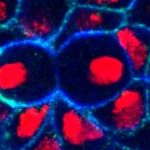Lien vers Pubmed [PMID] – 10409503
Development 1999 Aug;126(16):3573-84
The bristle mechanosensory organs of the adult fly are composed of four different cells that originate from a single precursor cell, pI, via two rounds of asymmetric cell division. Here, we have examined the pattern of cell divisions in this lineage by time-lapse confocal microscopy using GFP imaging and by immunostaining analysis. pI divided within the plane of the epithelium and along the anteroposterior axis to give rise to an anterior cell, pIIb, and a posterior cell, pIIa. pIIb divided prior to pIIa to generate a small subepithelial cell and a larger daughter cell, named pIIIb. This unequal division, oriented perpendicularly to the epithelium plane, has not been described previously. pIIa divided after pIIb, within the plane of the epithelium and along the AP axis, to produce a posterior socket cell and an anterior shaft cell. Then pIIIb divided perpendicularly to the epithelium plane to generate a basal neurone and an apical sheath cell. The small subepithelial pIIb daughter cell was identified as a sense organ glial cell: it expressed glial cell missing, a selector gene for the glial fate and migrated away from the sensory cluster along extending axons. We propose that mechanosensory organ glial cells, the origin of which was until now unknown, are generated by the asymmetric division of pIIb cells. Both Numb and Prospero segregated specifically into the basal glial and neuronal cells during the pIIb and pIIIb divisions, respectively. This revised description of the sense organ lineage provides the basis for future studies on how polarity and fate are regulated in asymmetrically dividing cells.

